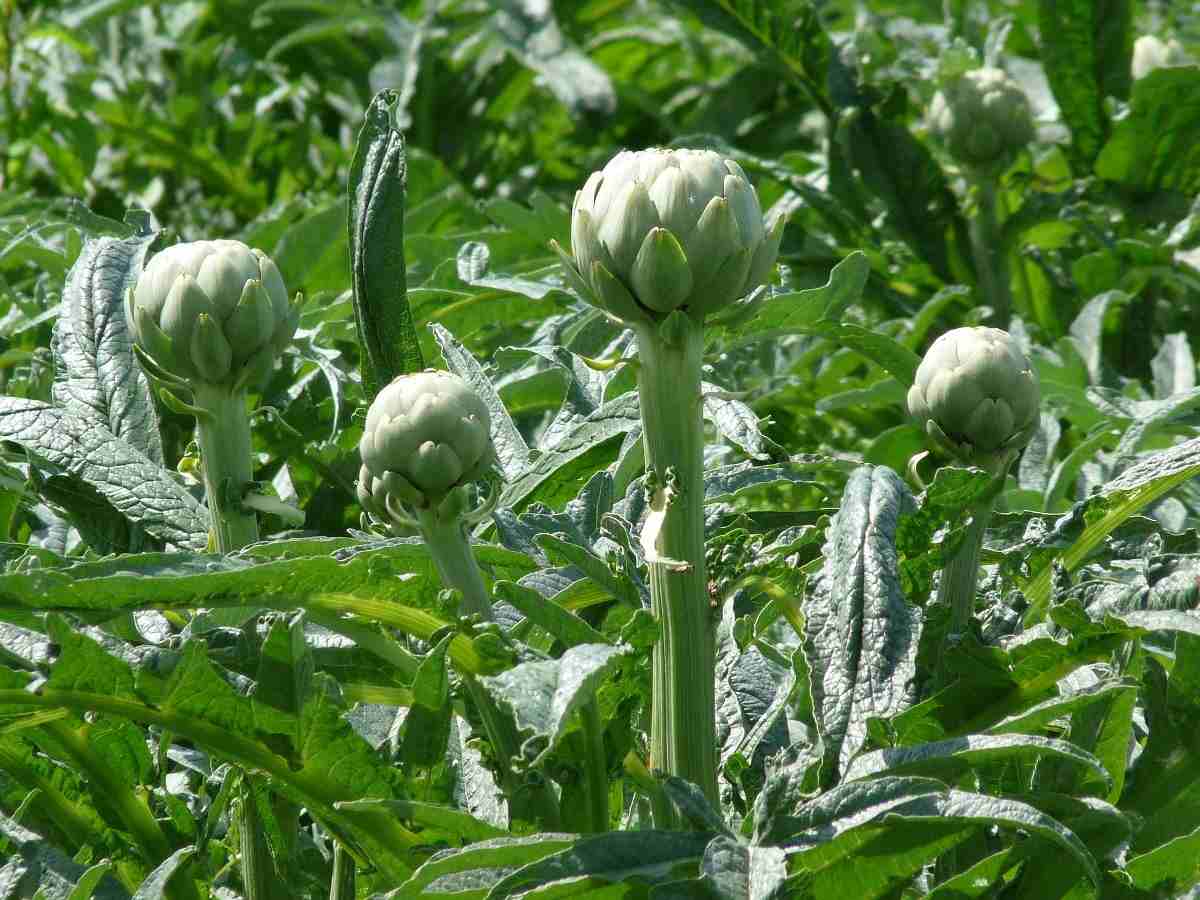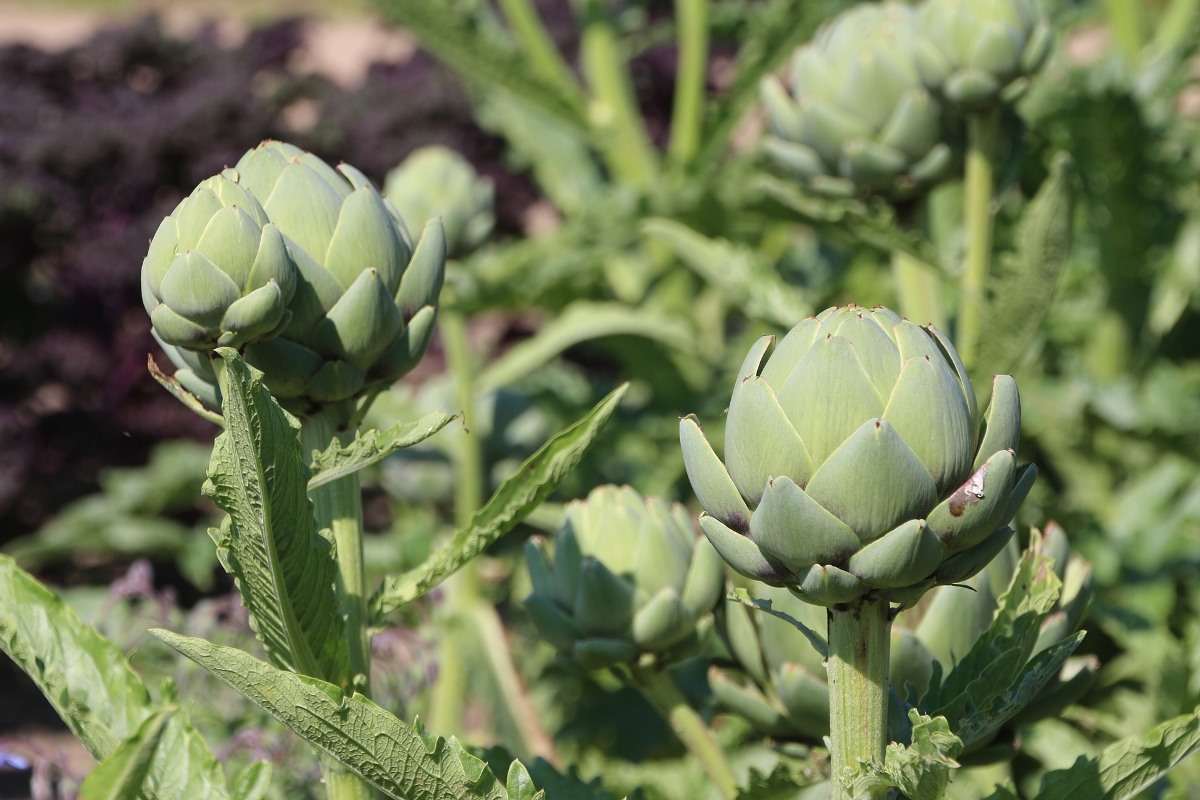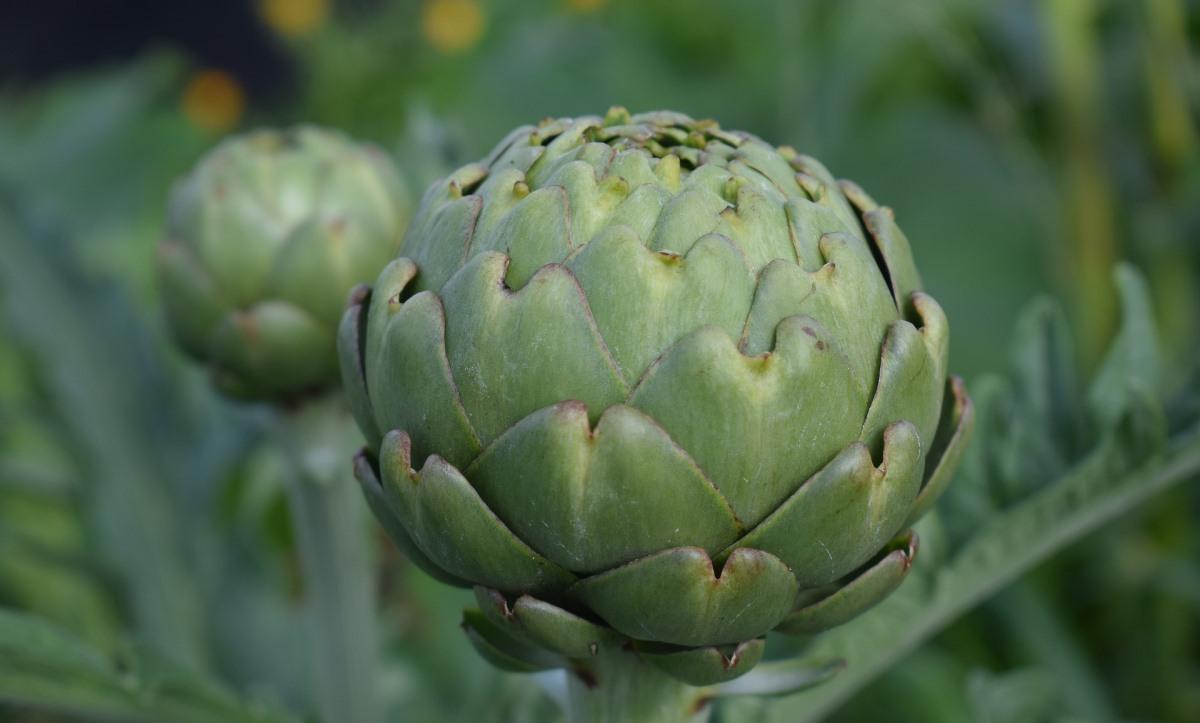Artichoke Growing Tips, Ideas, Techniques, Hints, and Secrets
Hello gardeners, we are back with a new and helpful topic today and the topic is all about artichoke growing tips, ideas, techniques, and secrets. Do you want to grow artichoke and do you want to know all the basic and important artichoke growing tips? Well and then you will need to follow this complete article to know all the tips, ideas, techniques, and secrets for growing artichoke.
Introduction to Artichoke
The globe artichoke, also known by the different names like French artichoke and green artichoke within the U.S., is a sort of a species of thistle cultivated as a food. The edible portion of the plant consists of the flower buds before the flowers inherit bloom. The artichoke is an edible thistle bud that’s eaten before it opens. Artichokes are tender perennials that grow from 3 to 4 feet or 9 to 1.2 meters tall and six feet across.
A Guide to Artichoke Growing Tips, Hints, Ideas, Techniques, and Secrets

They are native to the mild climates of the Mediterranean, and can’t survive extended cold temperatures. While most climates will leave annual artichoke growth, you’ll be ready to grow a perennial in some warmer climates. Wherever you reside, you’ll get to fertilize extensively, and to make sure they get enough—but not too much—water. Beat all, expect to start out growing your own artichokes in late winter and be chomping their immature flower buds by the autumn.
The Overview Table of Artichoke is Given Below
| Botanical Name | Cynara scolymus |
| Common Name | Artichoke, globe artichoke, French artichoke, and green artichoke |
| Plant Type | Herbaceous perennial |
| Mature Size | 3 to 6 feet tall and 4 to 5 feet wide |
| Sun Exposure | Full sun |
| Soil Type | Light, fertile and well-drained |
| Soil pH | Neutral that is 6.5 to 7.5 |
| Bloom Time | Late summer and early fall |
| Flower Colour | Purple |
Types of Artichoke Plants
The many different sorts of artichokes mean you’ll choose the right variety for your garden. A number of the foremost popular sorts of artichoke include:
- Green globe artichoke
It is considered the originally improved artichoke. It reaches harvest very early – at only 75 days.
- Big heart artichoke
It is an easy variety with no thorns. This relatively new variety can handle warm weather and maybe grown as an annual from seed. This artichoke’s name pays homage to its ability to succeed in up to five ½ inches.
- Violetta artichoke
It is an important producer of side buds. This heirloom variety from Italy has a beautiful purple bud known for its tenderness. As a smaller plant, the Violetta artichoke usually requires only 3-foot spacing between plants.
- Jerusalem artichoke
It is also referred to as a sunchoke. The Jerusalem artichoke isn’t an artichoke in the least, despite its name. It’s a species of sunflower, native to North America. This is much different than an actual artichoke; these plants grow from about 5 feet to over 9 feet, with sunny yellow sunflower-Esque blooms. The edible tuber portion resembles ginger root and is usually between 3 to 4 inches long.
Basic and Important Secrets for Growing Artichokes
In case if you miss this: How To Grow Cauliflower In Greenhouse.

- Keep the soil moist. Artichokes need many glasses of water to make the edible buds.
- Better mulch around the plants to stay the moisture within the soil.
- Apply a balanced organic fertilizer once monthly during the season.
- Remove the mulch when the plants begin to bud and canopy the soil around the plants with compost.
- When temperatures cool off in late summer and fall, the plants will start growing again and you’ll get a second harvest.
- In cooler regions, after the autumn harvest, cut the plants back to about 6 inches and canopy the crowns of the plant with leaves.
- For extra winter protection, add a foot of straw on top.
- Remove the straw and leaves after the last frost within the spring.
Artichoke Soil Preparation Tips
Artichokes prefer sandy and well-drained but fertile soil. A pH slightly on the alkaline side is perfect and best. Slightly sandy soil is right. Good drainage is crucial to stop the roots from rotting, especially in areas where they’re going to be overwintered. However, the soil must even be ready to retain water long enough to permit the roots to require it during hot summers.
When growing artichokes as perennials, it’s especially important to amend the soil before planting to make sure they’re going to grow well in future years. If your garden soil is poor, then consider growing your artichokes in raised beds.
Ideas for Growing Artichokes from Seed
Start seeds indoors, a minimum of eight weeks before your last frost date. Harden off the seedlings just before planting them outside, but don’t wait until all danger of frost has passed—artichokes got to experience a small chilling (not freezing) before they’re going to set buds. This will be accomplished just by putting your plants call at mid-spring and exposing them for every week to 10 days to temperatures of about 10°C or a touch lower.
If you are trying to save seeds from your artichokes, they’ll not grow true, producing plants that change greatly from your original plant. You’ll have better success with purchased seed that has been grown under controlled conditions.
Artichoke Planting Techniques
Sow seeds indoors. You’ll need to maximize the season in your area by getting a start together with your artichokes indoors. Start your seeds in individual 4 inches or 10 cm containers and leave them under fluorescent lights or in a heated greenhouse. In normal indoor temperatures, seeds will likely germinate within a week approximately. Increase the dimensions of planters as required.
To harden off the artichokes, you need to begin exposing seedlings to temporary outdoor sessions 6 weeks before the anticipated last frost date in your area.
Transfer seedlings outdoors. You need to move seedlings outdoors 3 to 4 weeks before the anticipated final frost. You would like to show the plants to a temperature below 7°C to trigger flowering. They ought to be about as tall as your hand. Plant the seedlings so that the crown, or top, of the plant, is simply above the soil line.
Cull weak seedlings. After 8 to 10 weeks, healthy artichoke seedlings will have stocky stems and two sets of leaves. Remove any that don’t.
Use transplants in especially cold climates. If you reside in a place that only has 90 to 100 days a year without frost, you’ll likely get to start your plants with transplants. Then decide to start growing your transplants indoors late within the winter or early spring. Harvest will occur in late summer or even in early fall.
Acquiring rooted shoots from a year-round greenhouse or online plant distributor may be a good way to determine transplants quickly.
If acquiring them yourself, then use a serrated knife to start cutting an offshoot under 10 inches or 25 cm tall that’s growing from the bottom of the plant. Dig around the offshoot to make sure roots accompany the offshoot as you remove it.
Plant artichokes a minimum of 3 feet or 0.9 meters apart. If possible, 4 feet or 1.2 m to 6 feet or 1.8 m between individual plants is even better. These plants have large, aggressive wingspans and need substantial room to grow. If you are using raised beds, then artichokes don’t necessarily need their own beds but do need ample space to spread their leaves.
Watering Tips for Growing Artichoke
Water your artichokes. Your plants require 1 to 1.5 inches or 2.5 to 3.8 cm of water per week. If this amount of water is of course provided by rain, then confirm you’re watering them accordingly. You need to water extra within the spring and summer to encourage the expansion of larger, thicker buds.
Make sure the soil around your plants can drain excess water. If the bottom round the plant becomes waterlogged, consider replanting during a raised bed.
Caring Tips for Artichokes in Winter
You may also check this: How To Grow Vegetables In Shade.

First off, for northern gardeners, then select a spread of artichokes like Green Globe or Imperial Star. These have a shorter season, hence are hardier than other varieties.
Once you’ve got grown the plant for a season and winter is approaching, it’s time to tackle artichoke winter care. There are three methods for overwintering artichoke plants.
- Artichoke winter care methods
Mulching: If the plant is within the ground, insulate the roots with a deep layer of mulch. Surround the whole plant with a net that rises above the plant. The wire cage should be 12 inches or 30 cm wider than the plant. Using landscape pins, then secure the cage to the bottom.
Fill the cage with a mixture of straw and shredded leaves. Leave the mulched cage place throughout the winter. When spring arrives and every one chance of frost has passed for your region, slowly remove a touch of the mulch, gradually exposing the plant over 2 to 3 weeks.
Container growing: Another best and good method for overwintering artichokes is to plant them in containers. Grow the plants in containers throughout the season or obtain plants grown within the garden when temperatures are cool and pot them. Potted artichokes need to be planted in rich potting soil mixed with compost.
Instead of heavily mulching the plants, you merely move them into a sheltered area like an unheated garage or cool cellar with a temperature between 2 to 10°C. No light is important for the plants. Before overwintering artichoke plants in containers, cut the plants right down to the crown when frost is imminent. Next, move them to the chosen area and water them every 4 to 6 weeks until spring.
Dig up and store. The ultimate method of artichoke winter care is perhaps the simplest and requires the smallest amount of space. Cut the plants all the way right down to the bottom when frost is predicted. Dig the crowns and rootage from the bottom and gently shake the maximum amount of soil possible from the roots.
Store these bare-root clumps during a box of sphagnum during a cold garage or a refrigerator. You should not let the box get wet or be exposed to freezing temperatures. Keep an eye fixed on the bare roots and take away any that become soft or mushy. When spring comes and every one danger of frost has passed, replant the bare roots.
Artichoke Fertilizing Ideas
Fertilize the soil before planting. Condition soil with nutrients your plants can begin eating as soon as they’re within the ground. For every plant, work on least 1 shovel filled with compost or aged manure into the soil. Alternatively, you’ll use 1 cup or 240 ml of high-nitrogen fertilizer. Add these food sources to the soil right before planting them.
Consider adding 1⁄2 cup or 120 ml of feather or feed also as 1⁄2 cup or 120 ml of bone meal to the soil also, for added nutrients.
Fertilize your plants as they grow. Artichokes depend upon a high-nitrogen diet to grow to their full potential. Use a water-soluble organic, and blend it consistent with the package instructions. Follow the package instructions on what proportion to supply.
Side-dress each plant with 1 to 2 pounds or 0.45 to 0.91 kg of aged manure just before you expect them to bud.
Artichoke Pests and Diseases Controlling Tips
- Artichoke curly dwarf virus
You need to use only certified planting material then remove and destroy infected plants to limit the spread
- Bacterial crown rot
You should not use infected crowns as planting material and then start plants from seed or disease-free transplants.
- Botrytis rot or grey mould
Plant in light, well-draining, fertile soils; avoid overcrowding plants and planting seeds too deeply; don’t wet foliage when watering, water plants at base; remove crop debris from the soil after harvest.
- Armyworms
Organic methods of controlling armyworms will include biological control by natural enemies which parasitize the larvae and therefore the application of Bacillus thuringiensis; there are chemicals available for commercial control but many are available for the house garden doesn’t provide adequate control of the larvae.
- Artichoke aphid
Destroy plant immediately after harvest to stop population spread; wash aphids from plants with a robust stream of water; insecticidal soaps or oils like neem or vegetable oil are effective organically acceptable methods of control.
- Artichoke plume moth
Pick all infested buds at harvest and destroy; cut plant stems above ground, shred plants and incorporate them into the soil; apply Bacillus thuringiensis or insecticide.
- Flea beetle
In areas where flea beetles are a drag, floating row covers may need to be used before the emergence of the beetles to supply a physical barrier to guard young plants; plant seeds early to permit establishment before the beetles become a drag – mature plants are less vulnerable to damage; trap crops may provide a measure of control – cruciferous plants are best; application of a thick layer of mulch may help prevent beetles reaching the surface; application on diamotecoeus earth or oils like neem oil are effective to regulate methods for organic growers; application of insecticides containing carbaryl, spinosad, bifenthrin, and permethrin can provide adequate control of beetles for up to every week but will get to be reapplied.
- Loopers
Looper populations are usually held in restraint by natural enemies and if they are doing become problematic larvae are often hand-picked from the plants; an organically acceptable control method is that the application of Bacillus thuringiensis which will effectively kill younger larvae; chemical sprays may damage populations of natural enemies and will and will be selected carefully.
- Spider mites
In the home garden, spraying plants with a robust jet of water can help reduce the buildup of tetranychid populations; if mites become problematic apply insecticidal soap to plants; certain chemical insecticides may very well increase mite populations by killing off natural enemies and promoting mite reproduction.
Artichoke Harvesting Ideas
- When to harvest artichokes
Artichoke plants live for about 5 years. Production starts a few years after planting. A mature plant will produce 10 or more stalks each season; each stalk will produce four to 5 buds.
When flower buds begin to make on stalks within the spring, check plants daily to make certain you narrow buds before they open. Buds that are allowed to open are going to be fibrous, stringy, and inedible.
An artichoke will produce several flower buds beginning in late spring. The bud atop each stalk will ripen first and buds lower on the stalk will follow—but won’t be as large because of the top bud.
Artichokes prefer cool summers; plants don’t bear well in hot, dry conditions; buds mature too quickly and become tough.
- How to reap artichokes
Cut artichoke buds from the stalk with a garden pruner or lopper; leave about 1 to three inches below the bud base. The stem you allow attached will make the thorny bud easier to handle and a few stems are tender enough to eat. Handle buds very carefully during harvest to avoid bruising bud petals.
Once all the buds on all of the stalks are harvested, cut the whole plant right down to slightly below soil level and reduce irrigation.
- Planting and Spacing Techniques in Papaya: A Beginner’s Guide
- Growing Gold: Essential Techniques for Planting Pineapples
- How to Make Kalanchoe Plant Bushy: Home Remedies and Solutions
- 11 Reasons Why Your Gardenia is Not Blooming: Home Remedies and Solutions
- Eco Elegance: The Guide to Designing a Drought-Tolerant Landscape
- Gardening on a Slope: Strategies for Hillside Landscaping
- Nourish and Flourish: Top Organic Mulches for Thriving House Plants
- Everything You Want to Know about Indian Mogra Flower: Discover Uses and Growing
- Green Thumb Success: Expert Tips for Cultivating Greenhouse Pumpkins All Year Round
- Maximize Growth & Flavor: The Ultimate Guide to Companion Planting in Herb Gardens
- How to Control Rhododendron Problems Naturally: Home Remedies and Organic Ways to Fix Them
- Natural Magic: The Remarkable Benefits of Cinnamon for Plants
- Best Steps to Revive Dying Tulip with Natural and Organic Treatment
- 10 Reasons Why Your Angel Trumpet is Not Blooming: Remedies and Treatment
- How to Fix Periwinkle Leaf and Flower-Related Problems: Natural Remedies and Solutions
- How to Fix Zinnias Leaf and Flower Problems: Discover Natural and Home Remedies
- Organic Steps to Induce Lemon Tree Flowers: A Comprehensive Guide
- Bloom Booster: Crafting the Perfect Homemade Bougainvillea Fertilizer
- Optimizing Growth: A Guide to Applying NPK Fertilizer for Potted Plants
- 10 Best Homemade Fertilizers for Rubber Plant: DIY Recipes and Application Method
- How to Boost Female Pumpkin Flowers: Effective Steps for More Flowers and High Yields
- Transform Your Indoor Garden: Top Benefits of Pink Salt for Houseplants
- 10 Best Homemade Fertilizers for Peacock Plants (Calathea): Easy DIY Guide
- Unlock Blooms: 9 Reasons Why Your Potted Chrysanthemum is Not Blooming